Atlantic Coast Line

the Atlantic Coast Line had two stretches of track in Virginia in 1905, including the former Norfolk & Carolina Railroad from Pinners Point
Source: Annual Report of the State Corporation Commission of Virginia - Volume 2 (1905), Chesapeake Western Railway (p.11)
After the Civil War, Virginia-based owners of railroad stocks and bonds lost control as corporations went bankrupt. The Virginia-based owners came from regions that competed for trade, and invested in railroads in order to transport freight from the interior "hinterland" to rival cities.
Business and political leaders in the ports of Alexandria, Fredericksburg, Richmond, Petersburg, and Norfolk were not interested building railroads that were just profitable businesses. They funded rival transportation networks to steer trade away from one port and towards another. Financing the most cost-effective expansion of railroads was a much lower priority.
Financiers from the northern states and England were focused the profitability of railroads, no matter what port was served by the lines. "Atlantic Coast Line" was used as a marketing tool staring in 1871 by several railroads in Virginia and the Carolinas. They synchronized their operations and rates in order to increase traffic and profits.
The different laws in different states, plus the challenge of finding the necessary funds to buy the stock and gain control of other railroads, complicated consolidation of different companies. The separate railroads did not formally consolidate, because state legislatures limited the ability of railroads to merge without special authorization which required special lobbying efforts. Over the next 30 years, the evolution of holding companies and less-restrictive state laws on incorporation led to formal integration into one company.
The unification of the separate lines started in 1893. The Atlantic Coast Line Company was created as a holding company for the Richmond & Petersburg Railroad and the Petersburg Railroad, plus three more railroads in the Carolinas. In 1898, the Richmond and Petersburg Railroad purchased the Petersburg Railroad. They were merged with the Norfolk and Carolina Railroad plus other lines into the Atlantic Coast Line in 1900.1
In Richmond, the Atlantic Coast Line continued the partnership started by the the Richmond and Petersburg Railroad with the Richmond, Fredericksburg and Potomac Railroad. Working together in 1866, they had built the Richmond, Fredericksburg and Potomac and the Richmond and Petersburg Connection Railroad to link their track in Richmond. The one-track Connection Railroad handled freight and passenger trains until 1891, when a freight-only bypass was completed upstream. The freight bypass was also just one track.
Between 1891-1919 the Atlantic Coast Line passenger trains coming north continued to stop at the Byrd Street Station. Passenger cars were transported via the Connection Railroad, on Byrd/Belvedere streets, to reach the Richmond, Fredericksburg and Potomac Railroad. In 1919 the Atlantic Coast Line and the Richmond, Fredericksburg and Potomac Railroad opened the new Broad Street Station for passengers, and replaced the 1891 Belt Line. The two-track replacement, which handled all freight and passenger trains continuing on the other railroad, included a new bridge across the James River. That bridge was made of poured concrete, rather than traditional iron beams.
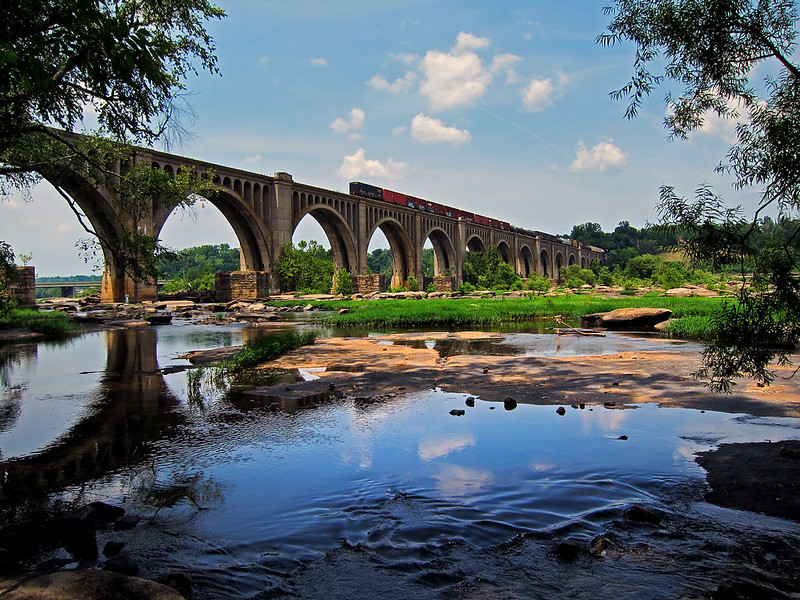
the new Richmond, Fredericksburg and Potomac Railroad and the Atlantic Coast Line bridge opened in 1919
Source: Taber Andrew Bain, CSX A-Line Bridge
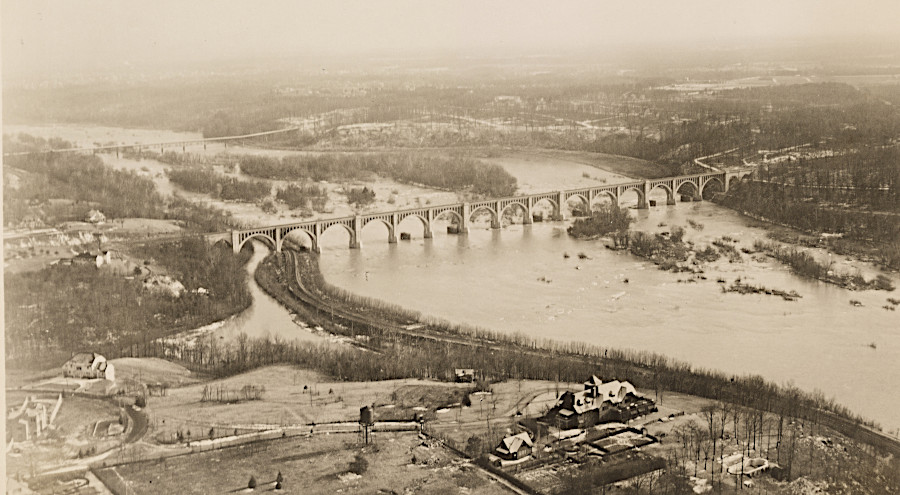
Atlantic Coast Line bridge over James River in 1920
Source: National Archives, Virginia - Richmond
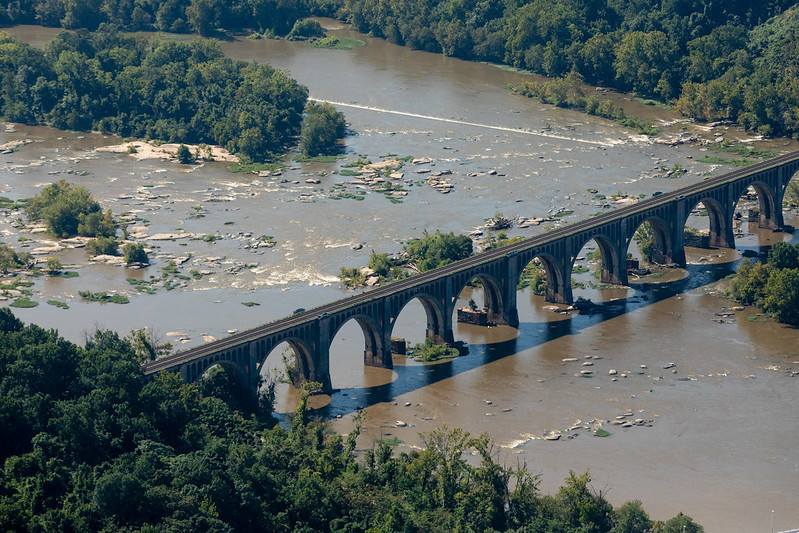
Belt Line Bridge over the James River in 2018
Source: Chesapeake Bay Program, James River in Richmond, VA
The Atlantic Coast Line partnered with the Louisville & Nashville Railroad to lease the Carolina, Clinchfield & Ohio Railroad in 1925. That streamlined the process of hauling West Virginia/Virginia coal south to textile mills and to the South Carolina port of Charleston.2
The Atlantic Coast Line purchased the Franklin and Carolina Railroad from Camp Manufacturing in 1958. The two lines met at Franklin Junction in Nansemond County (now the City of Suffolk). Camp had built the Franklin and Carolina Railroad in 1944 to deliver timber cut in the Great Dismal Swamp to its mills in Franklin, but had gotten the railroad designated as an interstate carrier by the Interstate Commerce Commission.3
Much of the Atlantic Coast Line traffic ran from Virginia to Florida, and the primary competitor was the Seaboard Air Line. The two lines provided common service to 121 locations between Richmond and Florida. To carry its traffic north of Richmond, the Atlantic Coast Line partnered with the Richmond, Fredericksburg and Potomac (RF&P) Railroad.
Construction of the interstate highways required streamlining railroad operations to compete with trucks for freight traffic and with cars for passenger traffic. After the Interstate Commerce Commission (ICC) finally began to authorize railroads to eliminate duplicate infrastruct and reduce operating costs, the Seaboard Air Line and the Atlantic Coast Line agreed to merge in 1960.
After seven years of legal fights, the merger was implemented in 1967. The railroad's names were combined to create the Seaboard Coast Line. That railroad integrated its operations with the Louisville & Nashville Railroad plus other independent railroads in the Southeastern United States to create "The Family Lines."4
After the Atlantic Coast Line and Seaboard Air Line Railroad merged, the Franklin and Carolina Railroad duplicated the mainline between Weldon and Portsmouth. The Seaboard Coast Line could move timber to Franklin via the track linking Franklin Junction to Suffolk, so the Franklin and Carolina Railroad was abandoned in 1972.5
In 1986, the new CSX Transportation Company absorbed the Seaboard Coast Line. What remains of the Atlantic Coast Line is now part of CSX.
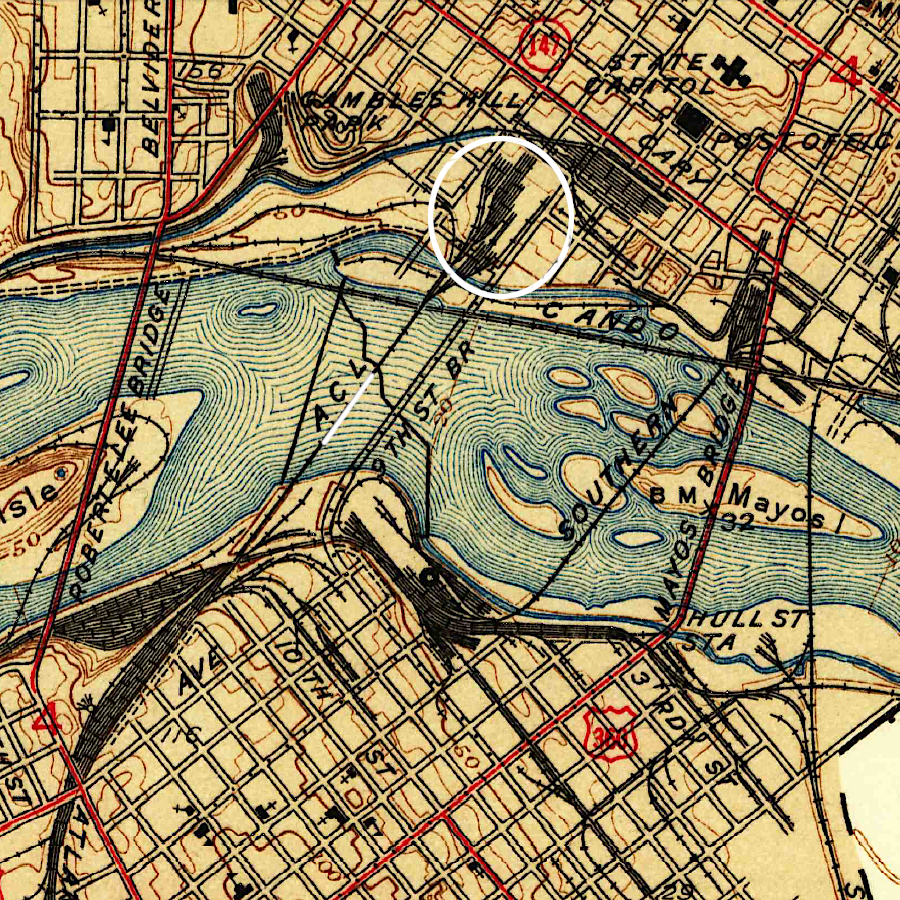
the northern end of the Atlantic Coast Line in 1939 was next to the current Federal Reserve building
Source: US Geological Survey (USGS), Richmond, VA 1:31,680 topographic quadrangle (1939)
Links
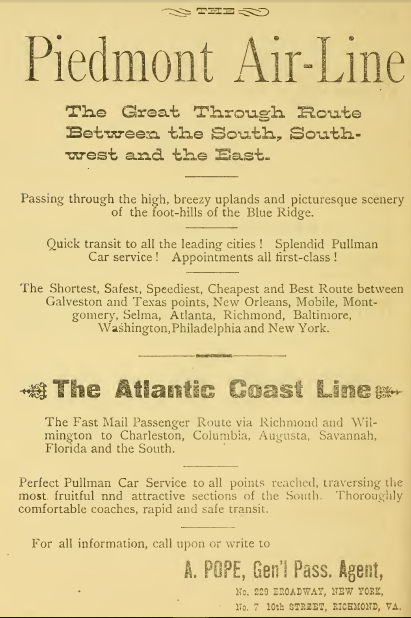
the Atlantic Coast Line competed with the Seaboard Air Line and the Piedmont Air Line
Source: Atlanta Illustrated (1881, p.243)
References
1. "Atlantic Coast Line, Standard Railroad of the South," American-Rails.com, https://www.american-rails.com/atlantic-coast-line.html; "Annual Report of the State Corporation Commission of Virginia. Compilations from Returns of Railroads, Canals, Electric Railways and Other Corporate Companies," Virginia State Corporation Commission, 1917, p.8, https://books.google.com/books?id=BN8lAQAAIAAJ (last checked June 30, 2020)
2. "North Carolina Railroads - Norfolk & Carolina Railroad," Carolana, http://www.carolana.com/NC/Transportation/railroads/nc_rrs_norfolk_carolina.html; George A. Kennedy, "Atlantic Coast Line Railroad," NCpedia, 2006, https://www.ncpedia.org/atlantic-coast-line-railroad; "Atlantic Coast Line Railroad," RailGA.com, http://www.railga.com/acl.html; "Richmond Rail History," Richmond Railroad Museum, https://www.richmondrailroadmuseum.com/railroad-history (last checked July 16, 2020)
3. Clifford A. Hedgepeth, Jr., "Dismal Swamp Operations of Camp Manufacturing Company and The Franklin and Carolina Railroad," Southampton County Historical Society, http://sites.rootsweb.com/~vaschs/Camp.htm (last checked April 22, 2020)
4. "Family Lines System Railroad," Rails Across the Appalachians, https://appalachian-railroads.org/homepage/railroads-across-the-appalachians/family-lines-system-railroad/; "Family Lines System (Railroad): Logo, Map, History," American Rails, https://www.american-rails.com/family.html(last checked October 11, 2025)
5. "Dismal Swamp Operations of Camp Manufacturing Company and The Franklin and Carolina Railroad," Southampton County Historical Society, http://sites.rootsweb.com/~vaschs/Camp.htm; "Looking back: Rites held for Camp," The Tidewater News, October 4, 2013, https://www.tidewaternews.com/2013/10/04/looking-back-rites-held-for-camp/; ; Clifford A. Hedgepeth, Jr., "Dismal Swamp Operations of Camp Manufacturing Company and The Franklin and Carolina Railroad," Southampton County Historical Society, http://sites.rootsweb.com/~vaschs/Camp.htm (last checked April 22, 2020)
Railroads of Virginia
Virginia Places





